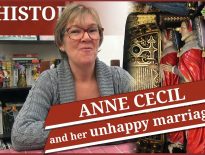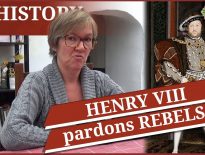On this day in Tudor history, 4th December 1555, in Rome, papal sentence was passed on Thomas Cranmer, resulting in Cranmer being deprived of his archbishopric. Permission was also granted for his fate to be decided by the secular authorities.
In today's "on this day in history", I explain what led Cranmer to this day and also what happened next. Thomas Cranmer went on to recant his Protestant faith on several occasions, but was still executed by being burned at the stake. Why?
Find out more in today's talk.
And here are my videos on his trial and execution:
Also on this day in history:
- 1506 – Birth of Thomas Darcy, 1st Baron Darcy of Chiche, courtier and administrator. He was the son of Roger Darcy, Esquire of the Body to Henry VII, and his wife, Elizabeth (née Wentworth). Darcy served as a Privy Councillor in Edward VI's reign, and also Captain of the Yeoman of the Guard and Lord Chamberlain of the Household. He was arrested for supporting the Duke of Northumberland's bid to place Lady Jane Grey on the throne, but was pardoned in November 1553.
- 1514 – Death of Richard Hunne, merchant tailor and leading member of the Lollard community in London. He had been arrested for heresy, and imprisoned in “Lollards' Tower” in St Paul's Cathedral on 14th October after the discovery of a Wycliffite Bible at his home, and his body was discovered hanging in his cell from a silk girdle. It was claimed that he had committed suicide, but a coroner's jury ruled that the hanging had been faked, and that he had been murdered.
- 1531 – Execution of Rhys ap Gruffudd for treason. He was beheaded after being accused of plotting against the King, although his biographer, R.A. Griffiths, points out that his trial was a “show trial” consisting of contrived testimonies and coached witnesses.
- 1557 – Death of Robert King, Abbot of Thame and Bishop of Oxford. He was buried in Oxford Cathedral. King was one of the judges who sat in judgement at the trial of Thomas Cranmer in 1555.
- 1585 – Death of John Willock, physician and Scottish reformer, at Loughborough in Leicestershire. He was buried at his church, All Saints, in Loughborough. Willock became the Chaplain of Henry Grey, Marquis of Dorset, and father of Lady Jane Grey, in the 1540s.
1595 – Death of William Whitaker, theologian and Master of St. John's College, Cambridge, at the master's lodge after going to bed with a hot “ague”. He was buried at St John's. His works included Liber precum publicarum (1569), Ad rationes decem Edmundi Campiani jesuitæ responsio (1581), responses to Nicholas Sander and Edmund Campion, Disputatio ad sacra scriptura and Adversus Thomae Stapletoni (1594). - 1609 – Death of Alexander Hume, Scottish poet and writer. He is known for his 1599 “Hymnes, or Sacred Songs”, which includes his great poem “Of the Day Estivall” which describes a summer's day, from dawn until dusk.
Transcript:
On this day in Tudor history, 4th December 1555, in Rome, papal sentence was passed on Thomas Cranmer, resulting in Cranmer being deprived of his archbishopric, that of Canterbury, and “of all the ecclesiastical dignities”.
This sentence is recorded by Bernardo Navagero, Venetian Ambassador at Rome, to the Doge and Senate:
“On Wednesday the 4th instant consistory was held, in which they deprived the Archbishop of Canterbury of the archbishopric, and of all the ecclesiastical dignities, and moreover permitted his delivery to the temporal judicature.”
Not only was he deprived of his office, permission was also given for the secular authorities to decide on his fate.
Thomas Cranmer had been consecrated as Archbishop of Canterbury on 30th March 1533 and he was responsible for annulling King Henry VIII’s marriage to Catherine of Aragon and proclaiming his marriage to Anne Boleyn valid. He also crowned Anne Boleyn queen on 1st June 1533 and baptised Elizabeth, daughter of Henry VIII and Anne Boleyn, and a girl who would grow up to be Queen Elizabeth I.
Cranmer was one of the king’s most trusted advisors and survived the fall of his patron, Queen Anne Boleyn, in 1536, as well as a plot against him by Catholic Conservatives in 1543.
Summer 1536 saw the publication of his Ten Articles, which defined the beliefs of the new Church of England, the Henrician Church that had been established after the break with Rome. Cranmer went on to work on The Bishop’s Book, the Act of Six Articles, and eventually, in Edward VI’s reign, the Book of Common Prayer.
In 1547, he held the dying King Henry VIII’s hand and gave the King a reformed statement of faith instead of the usual last rites. He was one of the executors of the king’s will.
In Edward VI’s reign, he was an important part of Lord Protector Somerset’s administration and in 1549 the Act of Uniformity established “The Book of Common Prayer”, which set out the new legal form of worship in England. Cranmer survived Somerset’s fall unscathed and worked alongside his successor, John Dudley, Duke of Northumberland. Cranmer worked hard on revising the Prayer Book and canon law, and also forming a statement of doctrine. The 1552 Act of Uniformity replaced the Book of Common Prayer with a more Protestant Book of Common Prayer and The Forty-Two Articles were issued on the 19th June 1553. However, the Forty-Two Articles were never properly authorised as some bishops opposed them. Cranmer was working on getting bishops to subscribe to them when King Edward VI died and scuppered all of these plans.
On the 6th July 1553 Edward VI died leaving his throne to Lady Jane Grey who he had appointed his successor in his “Device for the Succession”, which also excluded his half-sisters, Mary and Elizabeth, as heirs to the throne. Thomas Cranmer had opposed the documents but had reluctantly signed them when Edward had asked him to respect his will. Lady Jane Grey was proclaimed Queen after Edward’s death but her throne was seized by Mary I on 19th July. Although John Dudley and other members of council were imprisoned, Cranmer was not and on the 8th August 1553 he performed the Protestant funeral rites as Edward VI was buried in the Henry VII Chapel at Westminster Abbey. While other reformed clergy fled the country now that the Catholic Mary I was in control, Cranmer chose to stay but after proclaiming that “all the doctrine and religion, by our said sovereign lord king Edward VI is more pure and according to God’s word, than any that hath been used in England these thousand years”, he was ordered to stand before the Queen’s council on the 14th September in the Star Chamber. He was then sent to the Tower of London.
On 13th November 1553, he was found guilty of treason, along with Lady Jane Grey and others, and condemned to death. He was then moved to Oxford’s Bocardo Prison in March 1554, along with Bishops Hugh Latimer and Nicholas Ridley, and the three of them were tried in Oxford for heresy on the 12th September 1555. I’ll share with you my talk on this trial.
Ridley and Latimer were found guilty immediately and were burnt at the stake on the 16th October 1555, but Cranmer had to wait for a final verdict from Rome.
This verdict was given on this day in 1555.
The former archbishop went on to make four recantations, submitting himself to the authority of the monarch, Queen Mary I, and recognising the Pope as the head of the church. On the 14th February 1556, his priesthood was taken from him and his execution was set for the 7th March because Edmund Bonner was not happy with Cranmer’s admissions. Cranmer then made a fifth recantation, fully accepting Catholic theology, repudiating Reformist theology, stating that there was no salvation outside of the Catholic Church and announcing that he was happy to return to the Catholic fold. He participated in the mass and asked for sacramental absolution, which he received.
This should have been the end of things, but although his execution was postponed, Mary I then announced that it would be going ahead. On the 18th March, Cranmer made his final recantation but his execution date was set for the 21st March. On the date of his execution, he was given the opportunity to publicly recant at the University Church, Oxford. Instead of recanting, Cranmer opened with the expected prayer and exhortation to obey the King and Queen, and then renounced his recantations, saying that the hand he had used to sign them would be the hand that would be punished by the fire first and saying “And as for the pope, I refuse him, as Christ’s enemy, and Antichrist with all his false doctrine.”
He was executed by bring burned at the stake at Oxford on 21st March 1556 becoming one of the three Oxford Martyrs, along with Bishops Latimer and Ridley. You can find out more about his end in my talk for 21st March.



I really wonder why he didn’t leave the country immediately upon Mary’s accession. He had to have known he would be a lost cause with Mary. Michelle t